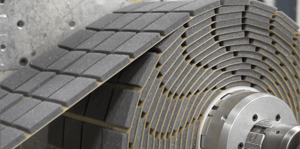You’ve ordered some die cut parts; now it’s time to throw them in a box and send them your way! …or not.
While your component arrangement may not seem like a big deal, it determines how smoothly you’ll be able to assemble your product. Formatting your die cuts correctly for application will save you significant time and money.
At Strouse, we format our part components to benefit the assembly of the final product. Learning the differences between these formats will help you confirm your choice with your converter.
Let’s compare rolled and sheeted die cut parts so you can understand your options and make the best choice for your project.
What Are Die Cut Parts?
Die cut parts are cut from flexible materials with a custom die tool, often in massive quantities, and used in product assembly. The uses of die cut parts range from medical device components to printed labels, depending on the materials used and the design’s intended purpose.
Die Cut Parts on a Roll
When die cut parts remain on a liner or backing with other parts instead of individually cut, they’re considered die cut parts on a roll.
PROS
- Good for high quantities
- Relatively easy to ship
- Ideal for product assembly automation
By storing parts in rolls, you can store high part quantities together in one place. Shipping is also easier for the converter because they can package the roll off the press.
One of the primary benefits of ordering die cut parts on a roll is improved product automation. If you’re hoping to automate your application, such as by implementing automatic dispensers, then parts on a roll will be more manageable to dispense, pick and place, etc.
CONS
- Aren’t intended for consumer use
Imagine you were using nicotine patches, but every time you went out, you had to lug around a roll of them in your bag. Goods on a roll aren’t ideal for the everyday consumer, but they function excellently in continuous production processes.
Sheeted Die Cut Parts
Unlike parts on a roll, sheeted parts are individually cut so that each part is standalone. Rather than being transported on rolls, they are bagged, pouched, or boxed.
PROS
- Easy for consumers to use/hand application
- Convenient for smaller or mid-sized project quantities
Sheeted die cut adhesive parts can function well in manual applications. This could function during product assembly or consumer use.
In addition, projects with smaller or mid-sized quantities are often performed using die cutting processes such as laser cutting. These products aren’t necessarily run on a rotary press, so it doesn’t always make sense to make parts on a roll.
You can also add fiducials to the liner to accommodate accurate placement via jigs for low-to-medium volume assembly.
CONS
- Require a low-tack carrier during production
- Additional packaging expense
Sheeted parts are cut during the converting process, but keeping them orderly after the final cut requires a low-tack carrier that can ensure the parts are appropriately dispensed rather than scattered. This carrier material is necessary for production but adds a slight expense to your final product.
There’s also an added expense in packaging sheeted parts because of the way you need them to be lined up. Packaging loose die cuts in an orderly manner is often a somewhat manual process, which adds time and cost to the total production.
Should I Get Parts on a Roll or Sheeted Die Cut Parts?
Listen.
The difference between parts on a roll and sheeted die cut parts might not feel like the most urgent fire to quench, but selecting suitable formatting will lead to a long-term production setup that ensures your product’s success.
Production doesn’t end when you have the parts in your hands— you want to have total confidence in the ease of your part application and how it leads to a finished product.
If you’ve read through the pros and cons of these die cutting formats, and you’re hoping to receive expert support, consider reaching out for a quote.
Otherwise, for more tips and advice on die cutting, feel free to look at our Learning Center.







